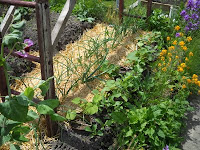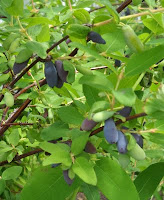 |
| Straw mulch |
 |
| Straw path |
Good things in the vegetable garden:

1. Schweiserreisen snow peas are ready to eat and it looks like they will be in production for a good long time. Seeds were sown over several weeks in April and May. The second batch are just starting to blossom and the third lot are still preoccupied with climbing their cages.
 |
| Costata Romanesca |
 |
| Papaya Pear |
 |
| Tiny Tim tomato |
3. Tomato blossoms are open and willing, even the Tiny Tim, which is no more than 8 inches tall yet. This might be a normal time for blossoms, or even late, but I'm relieved to see them after a late start, especially knowing that I can count on only another 70 frost free days. The plants finally have stakes and cages in place for support when they require it and have undergone a thorough de-suckering in the last week. Curious to see what the results of that will be.The potatoes also have blossoms, not yet opened, but I don't know what their purpose is.
 4. Scarlet runner beans have begun climbing their sunflower stalk poles. The Vegetable Gardener's Bible told me that pole beans and sunflowers are bad companions, after I had planted all of the beans and given them what I thought would be a great climbing structure. Vines certainly seem to prefer winding themselves around things that are approximately circles in cross-section. Sometimes vines wave around for days, and resist all coaxing on my part, before they commit to a climbing pole. Then they can't seem to move fast enough. We hope the red blossoms will draw hummingbirds this year.
4. Scarlet runner beans have begun climbing their sunflower stalk poles. The Vegetable Gardener's Bible told me that pole beans and sunflowers are bad companions, after I had planted all of the beans and given them what I thought would be a great climbing structure. Vines certainly seem to prefer winding themselves around things that are approximately circles in cross-section. Sometimes vines wave around for days, and resist all coaxing on my part, before they commit to a climbing pole. Then they can't seem to move fast enough. We hope the red blossoms will draw hummingbirds this year. 5. We remembered that we have shade cloth, a green mesh that is supposed to block just the right amount of sunlight (So much and no more, as Mr. Carp might say) to allow growth of the more heat sensitive species, like lettuce and radishes. Actually, I forgot to plant radishes last weekend, but we already have garden cress, lettuce, beets and pak choi sprouting away. It looks like they're camping. The ubiquitous quack grass is doing okay inside the shade cloth tent, too.
5. We remembered that we have shade cloth, a green mesh that is supposed to block just the right amount of sunlight (So much and no more, as Mr. Carp might say) to allow growth of the more heat sensitive species, like lettuce and radishes. Actually, I forgot to plant radishes last weekend, but we already have garden cress, lettuce, beets and pak choi sprouting away. It looks like they're camping. The ubiquitous quack grass is doing okay inside the shade cloth tent, too.6. Asparagus ferns are huge, some taller than me (the photo is a bit out of date.) We enjoyed all of four, or six, or eight spears of asparagus this spring, which is quite disappointing, since we were supposed to begin last year to reap the rewards of waiting through two years of root development. There were tense days after I had snapped off all visible spears and no more were apparently forthcoming. How would the roots be replenished? But the spears did finally emerge and unfold into substantial ferns. A couple of bees were busy in the flowers this evening. It bodes well for a better harvest next year.
7. Sun chokes (Jerusalem artichokes) appear to be thriving in all their locations. Shade from the boulevard trees does not seem to be a problem, nor does being planted in a box of earth and compost set atop a sheet of cardboard. Whether they can survive encroachment by everlasting sweet peas remains to be seen, but we are willing to intervene to a reasonable extent should they appear threatened.
These are the good things that come to mind, and this post has gone on long enough. Next time: the bad, possibly the ugly, perhaps the rather interesting.





No comments:
Post a Comment